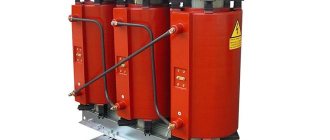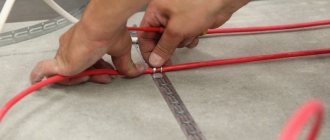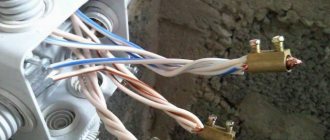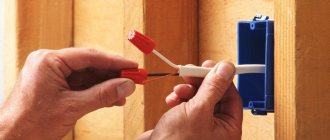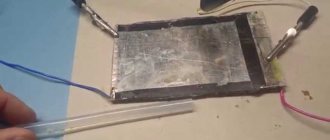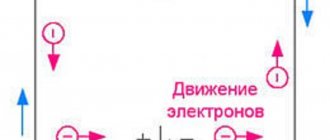We actively use electricity in every area of our lives. Of course, having electricity in the house is one of the main requirements for our existence. This electricity is supplied through wires. Moreover, they approach both the house or apartment itself and pass through all the rooms of our house. To transmit electric current, wiring made of aluminum or copper cable is used. The most popular is aluminum wiring. Actually, we will focus on such wiring in this article. First, I would like to note that aluminum wiring cannot boast of excellent performance characteristics. In other words, it cannot be called the most suitable or the most ideal. However, it is found in almost every home. And this fact is due to the characteristics of aluminum itself.
You can also use a calculator to calculate the conductor resistance or a calculator to calculate the cable cross-section for power and current.
Official bans
The “dislike” went so far that aluminum was officially restricted in its rights. Let's see what the official documents say about the use of aluminum, which should guide designers and electricians if they have an idea to use aluminum in their activities.
The first thing to note is PUE-7, clause 7.1.34 , which clearly states: “Cables and wires with copper conductors should be used in buildings (...).” We are talking about all buildings, except for industrial buildings - residential, public, administrative and domestic. In the same paragraph there is a footnote that states that aluminum was allowed to be used in buildings built before 2001. The ban on aluminum wiring was finalized by order of the Russian Ministry of Energy dated June 20, 2003.
Also, the PUE (Table 7.1.1) talks about the minimum cross-section of wires in the lines of group networks (inside our homes). Only copper wire with a cross-section of at least 1.5 mm² is allowed.
Another popular document is the Code of Practice SP 256.1325800.2016 “Electrical installations of residential and public buildings. Rules for design and installation” ( clause 15.3 ) – echoes almost word for word: “Internal electrical networks must be flame retardant and carried out with cables and wires with copper conductors, busbars with copper busbars (...).”
It’s worth making a reservation and jumping ahead a little: here I’m talking about the first version of these documents. I will write about the changes further in the text.
At the same time, both documents state in the same paragraphs that aluminum still has the right to life. PUE, (clause 7.1.34): “Supply and distribution networks, as a rule, must be made of cables and wires with aluminum conductors, if their design cross-section is 16 mm2 or more.” In the SP (clause 15.3) the wording is more streamlined - “use is allowed.” In any case, such a section in an apartment can only be used as an input, and it will not be possible to connect an outlet.
But why is aluminum allowed to be used if it is so problematic?
Power cables with aluminum core: design
The power cable with aluminum core has a standard design for cable products. Single-wire or multi-wire aluminum conductors (not pure aluminum, but an alloy) are surrounded by PVC insulation. All cable cores are twisted into a bundle and surrounded by a common PVC sheath. Depending on the modification, the cable may additionally be protected with armored tape and/or have additional paper insulation. Cables with this design are called power cables with an aluminum core in PVC insulation and they are the most widespread.
The following popular brands of aluminum power cables can be distinguished:
Similar
Pros of aluminum
With the same cross-section of wires made of copper and aluminum, the disadvantages of aluminum outweigh its main advantage - the price.
But it’s not for nothing that the documents indicate a certain limit - 16 mm². After this, the price of the cable becomes a decisive factor, and copper fades into the background. But the price is not only the cost of electrical wiring. There is another important circumstance due to mentality. Large squares are usually (or rather always) located outside residential premises. This means that such a cable, if it is copper, can “lie poorly” and can be “damaged.” With aluminum this risk is less.
It is necessary to compare copper and aluminum at the same maximum permissible current that the compared specimens can withstand.
I was not too lazy, went to the site (too famous to name) and compared prices for copper and aluminum cables, identical in terms of permissible continuous current.
Comparison of the price of copper and aluminum cables, identical in terms of permissible continuous current
As can be seen from the table, the difference is significant. Moreover, with 16 mm² aluminum becomes full-fledged and legitimate according to all laws. Starting with a section of 10/16 (copper/aluminum) with a difference in price of 3 or more times, the savings are huge.
What about smaller sections? There, after all, the savings are even greater - 5 times or more! I would like to save money, but I can’t - as I said above, it is prohibited to use aluminum cross-sections less than 16 mm².
However, in the same paragraphs (PUE 7.1.34, SP 15.3) there is a “loophole” - the engineering equipment of buildings (pumps, fans, heaters, etc.) can be carried out with wires and cables with a core cross-section of 2.5 mm or more. For example, if fire pumps and smoke removal pumps in a multi-story building are connected with aluminum cable, you can save tens of thousands of rubles!
Advantages and disadvantages of aluminum
Aluminum cable products have their own advantages and disadvantages, on the basis of which the material is selected for specific tasks.
Advantages:
- Price. The cost of the cable plays a decisive role in large production volumes. However, it should be borne in mind that if an aluminum cable is significantly cheaper than a copper cable with a similar cross-section, then when comparing copper and aluminum with different cross-sections, but comparable permissible current load, the difference in cost is not so significant.
- Weight. Aluminum cable weighs about half as much as copper, so when laying aluminum along overhead lines, you need half as many supports. This reduces line construction costs.
Flaws:
- Fluidity. Aluminum cables and wires are mostly made of soft alloys, and this has a detrimental effect on the quality of contact. During operation, contacts with aluminum deteriorate (especially on twists and screw terminals) and need to be periodically tightened. This is due to its fluidity.
- Oxidation. When an aluminum conductor operates in a humid environment and in air, it oxidizes. In this process, the surface of the core is covered with an oxide film, after which the oxidation processes stop. Because the resulting film prevents their development. On the one hand, in this way aluminum protects itself from complete rotting, and on the other hand, the oxide film does not conduct current. Consequently, the contact first begins to heat up intensely as the contact resistance increases, and then disappears altogether.
- Fragility. Most aluminum wires break if you bend them several times. This leads to problems both at the installation stage of the electrical installation and during maintenance, for example when replacing sockets and other electrical equipment.
However, some of the disadvantages, such as fluidity, depend on the specific manufacturer and brand of product, because Various alloys are used in this area.
How to turn a minus of aluminum into a plus?
With new technologies, a lot has changed in recent years.
Technologies for the production of aluminum alloys also do not stand still. Several years ago, Russia mastered the production of aluminum alloys of grades 8176 and 8030 (common name - 8000 or 8xxx), which include copper, iron and other additives. Technical conditions for these alloys are given in GOST R 58019-2017.
Production has been mastered, but its use is prohibited, what to do? Changes were made to PUE 7.1.34, which I wrote about above. For this purpose, a multi-pass procedure was carried out. Watch your hands.
On October 16, 2017, the Ministry of Energy of Russia issued Order No. 968 “Safety Rules for Power Receiving Installations. Features of electrical wiring in buildings with conductive copper conductors or conductors made of aluminum alloys.” As I briefly understood the essence of this Order, aluminum wiring with a cross-section of less than 16 mm² is approved for use in residential buildings if it meets certain requirements - in particular, the resistance and chemical composition of the conductor . The minimum permissible cross-sections for different types of supply lines are also indicated.
It turned out to be an incident (of which, however, there are a lot in the regulatory framework) - both the ban was in force (PUE, clause 1.7.34) and the permit for aluminum wiring (order No. 968).
To overcome this contradiction, on December 20, 2017, the same Ministry of Energy issued another order - No. 1196 , which states in plain text that the 1st and 6th paragraphs of clause 7.1.34 of the PUE are invalid. That is, the requirement “Cables and wires with copper conductors should be used in buildings” and Table 7.1.1 have been canceled.
And here it turns out that, in particular, cables of the type AsVVG (for fixed wiring, with flexibility class 1) and AsKG (analogue of copper flexible cables, with flexibility class 5), the conductors of which are made of aluminum alloys 8xxx, are ideally suited to the actions of Order No. 968 . And only them. Although this is not stated explicitly.
Cable AsVVG – 4 cores
It seems that the secret information from my good friend Public Health has been confirmed - changes in legislation occurred at the instigation of the RusAl company and cable manufacturers that are part of the Aluminum Association.
What about the set of rules SP 256.1325800.2016? Regarding aluminum, changes No. 2 and No. 3 , approved and put into effect in 2022 by orders of the Ministry of Construction No. 588/pr and No. 288/pr. They are much more specific.
These changes, first of all, change clause 15.3, which I mentioned above: “Internal electrical networks must be flame retardant and made with cables and wires with conductors made of copper or aluminum alloys of grades 8030 and 8176 (...).” Table 15.3 and some other paragraphs have also been added, which include conductive cores made of new alloys. Table 15.3, which lists copper and new aluminum alloys, talks about minimum cross-sections. The minimum cross-section for socket groups is 2.5 mm2. This is a more strict rule than in the PUE (Table 7.1.1). Plus, it's newer. Therefore, we always set 2.5 mm2 on sockets, regardless of the machine.
In addition to the PUE and SP, changes have been made to GOST 31996-2012 “Power cables with plastic insulation for a rated voltage of 0.66; 1 and 3 kV”, which now produces not only cables with a copper core, but also cables with a core made of new alloys.
Aluminum cable grades
AVVG - with aluminum conductors and double vinyl insulation. Perhaps one of the most common types of cables. Used in 0.66/1 kV networks with an alternating current frequency of 50 Hz. Available in a range of sections from 2.5 to 240 sq. mm. With a number of cores from 2 to 4. It is used for stationary connection of electrical equipment to the power supply network; it can also be used in rooms with difficult conditions, for example, partially flooded, with high humidity or explosive. It can be used as a conductor for power wiring; in fact, it is actively used in 0.4 kV networks. It is also used for wiring in residential buildings, suitable for connecting sockets and in production.
AVBbShv - with aluminum conductors and tape armor, PVC insulation of each conductor and a layer of encircling insulation, or rather, a PVC hose on the outside. The number of cores is from 1 to 5, and their cross-section is from 2.5 square meters. mm up to 240 sq. mm. Rated voltages are 0.66-1 kV and 50 Hz AC frequency. It can be used for laying wiring and connecting electrical installations to the power supply network in difficult conditions, as well as in cases of mechanical damage, in explosion and fire hazardous areas. Including for outdoor installation and underground, for example, for introducing a power cable into a house. Armor consisting of two tapes allows you to lay a line without additional protection from rodents. For sections greater than 6 sq. mm. the insulation is enhanced by a layer of cross-linked polyethylene and a cover of bitumen.
ASBL - armored with steel strips, as well as in a lead sheath. The number of cores is from 1 to 4, their cross-section is in the range of 16-800 sq. mm. Used for work in electrical installations with voltage up to 10 kV. Depending on the flexibility class and cross-sectional area, current-carrying conductors can be either single-wire (monolithic, abbreviated “OZH” in catalogs) or multi-wire. The cores are covered with paper insulation and enclosed in a screen made of electrically conductive paper. They are enclosed in a lead sheath, and the cushion is made of bitumen, crepe paper and PVC film. Can be used for laying in soil with low and medium corrosive activity.
APvPug - armored for lines with voltage up to 6-10 kV with a frequency of 50 Hz. Type of armor – steel belt. Insulation – cross-linked polyethylene. Designed for installation in the ground: trenches and soil, regardless of the degree of corrosive activity. Therefore, it is sealed and protected from moisture penetration. It can be used for overhead lines, and if proper fire protection is provided (application of fire retardant coatings) and in buildings. The range of sections is from 50 to 800 sq. mm, stranded cores. In addition, the cable has a copper wire screen with a cross-section of 16-35 square meters. mm secured with copper tape. The materials make it possible to lay it even in navigable and non-navigable water bodies, provided that the possibility of mechanical damage to the cable is excluded.
AABL - armored, for installation in 1-10 kV networks. The cores can be single-wire or multi-wire, insulated with impregnated paper, on top of which a belt insulation made of semiconducting paper is placed. This is all enclosed in an aluminum shell and armor made of two steel strips. Permissible voltages are indicated in the markings, for example ААБл 1 – 1 kV, ААБл 6 – 6 kV, ААБл 10 – 10 kV, respectively. Section range 50-240 sq. mm. Can be used in any location from moderate to cold climates. This type of cable cannot be used for laying vertical sections of lines; there is a special one with non-draining impregnation TsAABL-10. This grade can be laid in soil with low corrosive activity.
ААШв – with paper insulation of aluminum conductors covered with a layer of general vinyl insulation. Used in networks up to 10 kV (or up to 6 kV depending on the specific product version). The cores can be single-core (marked “OZh” or “OK”) and stranded (marked “mk”, “ms”, “mzh”). When laying one cable, the insulation does not spread fire. The paper insulation is impregnated with such a viscous composition that it does not leak out, and when connecting the cable, air inclusions do not form in the couplings. The screen is made of electrically conductive paper. The number of cores is from 1 to 4, and the range of their sections lies in the range of 50-800 sq. mm.
In conclusion, I would like to note that recently there has been more and more talk that aluminum will return to household electrical wiring. It is difficult to name the real reason for this. Manufacturers are promoting new cables made from non-flowing hard alloys, as well as the development of aluminum cables coated with a layer of copper. Skeptics argue that these are attempts to increase income from the sale of their products. In any case, you need to know the types and brands of aluminum wires and cables in order to use them correctly.
What is the asking price?
I wonder how the price of “new” aluminum will change compared to old? I made this comparison table:
Comparison of prices of “old” aluminum cables and new ones, with an 8xxx aluminum core
It can be seen that the price of cables that entered the legal field a couple of years ago differs by 2.5-3 times from cables with “old” aluminum. Competitive advantage! However, their price is significantly lower than copper ones with a similar permissible continuous current.
Further, the prices are almost the same, since cross-sections of 6 and 10 mm² are practically not used in residential wiring, and if a larger cross-section is required, even older brands of cables can cope quite successfully and legally.
Comparison with copper wiring
Note that it will be much simpler and safer to use copper wiring. We indicated above that copper wiring is characterized by lower resistivity. In other words, a copper cable with the same cross-section as an aluminum one can carry more current. In addition, copper electrical wire:
- is more resistant to physical impacts (it does not break after several bends);
- has a long shelf life;
- does not lose its conductive properties during oxidation.
A notable fact is that aluminum and copper oxidize. However, the films that are formed have different properties. First of all, this concerns current conductivity. As we have already noted, the oxidation film of aluminum wiring has poor conductivity. A similar film on copper wiring has high current conductivity. Electrical wires made of aluminum oxidize much faster than copper wires.
Copper oxidizes at room temperature, but the film that appears on the surface of the copper is very weak and easy to destroy. To do this, just twist the two cables tightly. Strong oxidation of copper begins when the temperature rises above 70 degrees Celsius. We can conclude that copper cable is of higher quality and, most importantly, safer. The reason for the popularity of aluminum lies in its cheapness.
Important clarification for aluminum opponents
It is clear that professional electricians, who every day see burnt strands of copper and aluminum and melted terminals with aluminum wires, are categorically against the innovation. Therefore, it is important to clarify:
- aluminum will only be used in new buildings (apartments, houses), where ALL wiring will be aluminum, connections and transitions to copper will be made by professionals, and the quality of work will be confirmed by examination. At least that's how it should be;
- It is allowed to use only 8xxx aluminum alloys, from which the current-carrying core of the AsVVG and AsKG cables is made. Cables based on “old aluminum” are not subject to the new changes and are still “outside the law”;
- no one prohibits the use of copper wires - if the client is willing to pay for copper, as before, please! Something tells me that now the price of copper cables may decrease slightly due to competition with new aluminum.
The main thing is that developers will have a completely legal way to make the price of electrical wiring in “construction option” apartments 10-15% lower than before. In secret from the same open secret, the majority of large developers (for example, Glavstroy, PIK) recently made a final decision - to use aluminum cable instead of copper at all newly built facilities.
Cables ABBГ, ABBGE
Cables of the AVVG, AVVGE brands are intended for laying cable lines in cable structures and premises.
Cables of the AVVGE brand, in the design of which an electrically conductive screen made of wires or tapes is placed under the sheath, are recommended for installation in rooms with a high required level of electrical protection, incl. for use in hazardous areas.
The operating temperature of the cable should be no more than 70 degrees Celsius. The power cable can be heated up to +160 degrees if it is protected with polyvinyl chloride insulation, and up to +130 degrees if the cable is protected with polyethylene insulation.
What about the sockets?
The cable is not used on its own. As a rule, in apartments it starts from the terminals of circuit breakers and zero buses, and ends at electrical installation products (EUI).
Most manufacturers of model equipment, even before the changes were released, indicated the possibility of connecting both copper and aluminum conductors to the contact terminals. But there was also a small clarification: once every 6 months you need to extend contacts.
After the changes were released, EUI manufacturers quickly came to their senses and began producing sockets and switches with special terminals. It is also important that these terminals accept a conductor with a cross-section of 4 mm² without any problems.
Quart sockets for copper and aluminum up to 4 mm2
To make everything official, changes were made to GOST IEC 60884 for household sockets and GOST IEC 61545 for contact connections (2022 versions). For those who like to dig deep, I recommend checking it out.
Pros and cons of aluminum wires
Usually, it depends on the characteristics of the positive and negative aspects of the material whether it is suitable for achieving certain goals.
Among the advantages of aluminum wires and cables are the following:
- Product cost. If you need a lot of materials, price plays an important role. In general, aluminum is cheaper than copper. But it is worth taking into account that if you select copper and aluminum conductors with different cross-sections and similar power, the price difference will be minimal.
- Aluminum weight. Aluminum weighs several times less than copper. Because of this, conducting over the air requires less time and money, since the cable does not need additional supports. Installation costs are significantly more economical.
Among the disadvantages of aluminum wires and cables, we highlight:
- The material has fluidity. Since the alloy is soft, the contacts are less reliable than when installing copper conductors. Due to the fluidity of wiring, it is necessary to update and maintain it from time to time as the contacts wear out and become loose.
- Oxidizes quickly. If a wire or cable is exposed to moisture and air, it will quickly oxidize. The surface will be covered with a film, after which oxidation will stop. We can say that the conductor protects itself, but it prevents the current from passing. For this reason, the contact will fail faster due to constant heating and increased resistance.
- Aluminum is more brittle than copper. Such conductors do not have much flexibility, and the aluminum may burst when bent. Because of this, conductors can be damaged even during the installation and installation of electrical equipment.
In general, some shortcomings can be eliminated by manufacturers. For example, the fluidity of the wire or cable material depends on the alloy.
More about wires
SIP wire
- The marking stands for “self-supporting insulated wire”.
- Used on lines with a voltage of 35,000 Volts.
- From one to four veins.
- The abbreviation may contain numbers and letters. "A" indicates a zero insulated core.
- The veins are protected from exposure to ultraviolet rays.
- Features can be identified by markings.
- There are wires made of aluminum and steel.
Used for power lines.
Automatic reclosure wires
- The core is monolithic, there is a layer of insulation. The insulation is made of polyvinyl chloride.
- Cross section from two and a half to sixteen square millimeters.
- Conducted in different places.
- At the standard value, hertz is designed for voltage values up to 1 kV.
Used for circuits, panels and power supply of lighting elements.
Wire A
- There is no insulation.
- Consists of many twisted wires.
- Cross section from sixteen to seven hundred and fifty square millimeters.
Used on power lines, usually laid by air.
AC wire
- There is no insulation.
- There is a steel core, this differs from the “A” grade wire.
- More resistant to mechanical damage.
- Has increased rigidity.
The application is the same as for grade “A”.
Conclusions – cautious
It is not entirely clear to me how the reliability and safety of electrical wiring increases, as stated in the orders. It is unlikely that new alloys surpass the classic “GOST” copper in their parameters. It is not clear how reliability will increase.
Since, with all identical parameters, the cross-section of the core and the diameter of the cable will be increased, this will complicate the life of the electrician - after all, connecting and laying cables will be difficult. There is no doubt that ordinary hard workers who will need to master new technologies will spit at first.
Personally, I am not against business and technology development. The main thing is that the use of 8xxx aluminum alloys really gives the advantages that are stated - low price, safety and reliability.
Wait and see!
Addition
The topic is well covered here – https://aluminium-guide.com/novaya-alyuminievaya-provodka/
and in my group VK SamElectric.ru.
The article was originally published on the Elec.ru portal here: Old New Aluminum, as well as in the Electrotechnical Market magazine.
The magazine article can be downloaded and read here: • Old new aluminum / Article in the journal Electrical Engineering Market, pdf, 2.5 MB, downloaded: 130 times. /
That’s all, I’m waiting for interesting comments!
